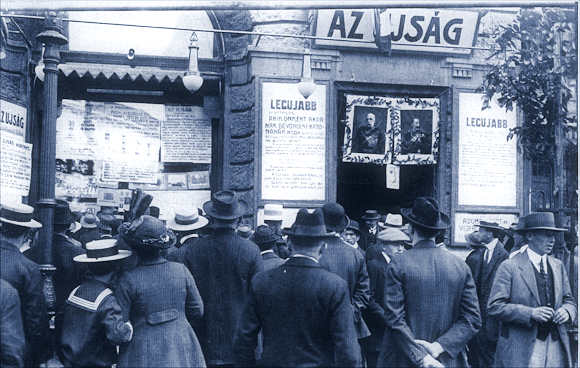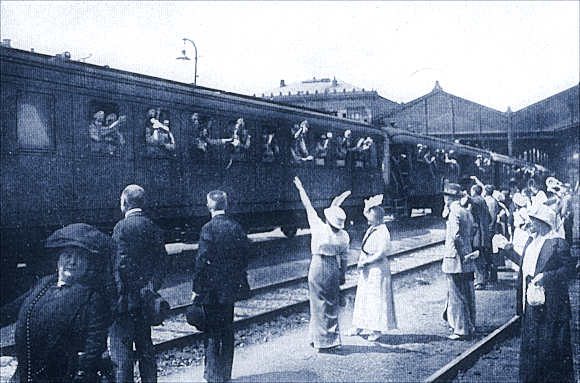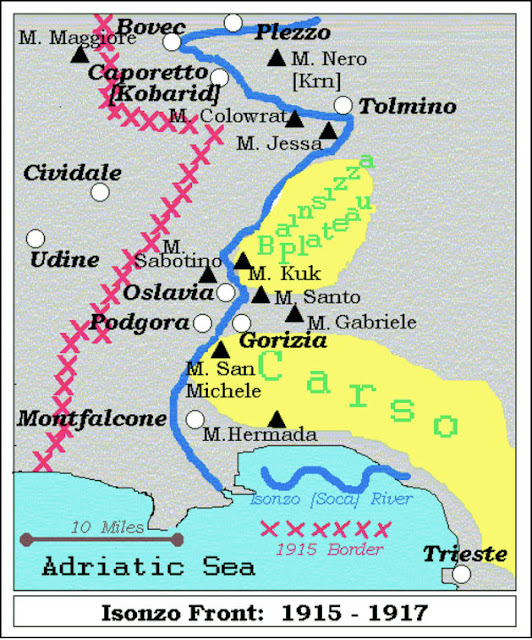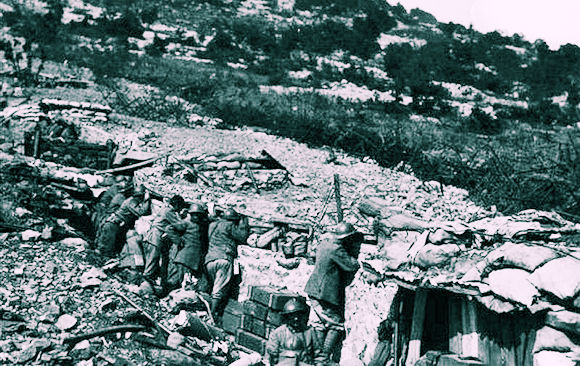 |
William Thomas, Boy II,
Sometime Around the Turn of the Century |
By David F. Beer
My grandfather, William Thomas, was born on 1 June 1880 and joined the Royal Navy on 27 January 1896, having exaggerated his age by one year. His initial rank was Boy II, but by June of 1898 he had advanced to Ordinary Seaman. He was at sea for years on the China Station before the Great War began, but on 1 August 1914 he was assigned as an Able Seaman to the battleship HMS Ocean.
I suffer the same regret so many of us do: why didn’t I ask my grandad about his navy life while I still had the chance? He was an affable old chap in the ‘40s and ’50s who enjoyed a pipe of tobacco and an occasional drink. We chatted a lot whenever I saw him, and there would have been time to ask about his long naval life, but young gormless twit that I was then, it never occurred to me. All I remember is that his navy hammock, which he had slept in for years, was folded away in a corner of his garden shed.
Fortunately, my older brother, Peter, at one point acquired a copy of grandad’s Certificate of Service in the Royal Navy: four handwritten sheets with the names and dates of every ship he served on. (I've included the list of those ships at the end of this article.) There were many, but with an interest in World War One, I want to focus on two: HMS Ocean and HMS Albion.
 |
| William Thomas During the War |
Thirty-four years old by 1914, William Thomas had come a long way—and been to many ports—when war broke out. A few days before war was declared he found himself as an Able Seaman aboard HMS Ocean. She was a pre-dreadnought battleship launched in 1898 that had seen service in the Mediterranean and the Far East. Able Seaman Thomas had been on board for some six months when Ocean was transferred to the Dardanelles in late February 1915 to participate in events there. He was on her when she sank off Helles on 18 March 1915.
Life aboard Ocean would have been hectic during her short time on station at the Dardanelles. On 28 February, she was firing at Turkish positions on the peninsula and trying to locate guns active near Sedd el Bahr, at the tip of Cape Helles. She and HMS Majestic came under fire from several Ottoman batteries, including howitzers. On 4 March, she supported the landings of two companies of Marines at Sedd el Bahr. More gunnery battles ensued on a daily basis. On 18 March, Ocean joined ten British battleships and one battlecruiser and four French battleships to attack the Ottoman defenses. The battleships were to enter The Narrows and suppress the fortresses while minesweepers cleared paths in the Ottoman minefields.
This operation failed. Several ships took considerable damage from Turkish shore batteries. The French battleship Bouvet struck a mine and exploded with a terrible loss of life. HMS Irresistible was disabled by a mine in Erenköy Bay. Ocean was sent to tow her out, but ran aground while trying and, after freeing herself, was unable to take Irresistible under tow because of the shallow water plus Irresistible's increasing list and heavy enemy fire. Ocean then took off the remaining members of Irresistible's crew and left the abandoned battleship, which sank at around 19:30 on 18 March.
 |
| Rescued Crewmembers from HMS Ocean |
While retreating, Ocean was hit by artillery fire and then struck a drifting mine at around 19:00. According to records, “her starboard coal bunkers and passageways flooded, her steering jammed hard to port, and she took on a list of 15° to starboard. She came under [more] fire from shore and began taking hits, which flooded her starboard engine room and prevented steering repairs.” Three destroyers came alongside and collected her crew, including my grandfather. She then drifted into Morto Bay, an inlet on the southwest tip of Cape Helles, still under fire, and sank there at about 22:30 on 18 March. No one saw her go down. The next day Able Seaman Thomas was transferred to nearby HMS Albion.
Being aboard Albion was no picnic. She had supported the first Allied landings in late February and early March 1915 and was already battle-damaged. William Thomas was present as she supported the main landings at V Beach at Cape Helles on 25 April 1915. According to my brother, our granddad was in charge of one of the landing boats at this time and was horrified at how badly the troops were torn up by Ottoman gunfire. Three days later, the Albion suffered significant damage from enemy shore batteries during an attack on Krithia. This forced her to retire for repairs to Mudros, the small militarized Greek port on the island of Lemnos some 31 miles away. Back in action on 2 May 1915, she was again damaged, and returned to Mudros once more.
 |
Depiction of the Landings on V Beach, 25 April 1915
William Thomas Was in Charge of One of the Towed
Landing Boats Shown on the Left |
When Albion again returned to Helles, she had more bad luck. On the night of 22–23 May 1915, she beached on a sandbank off Gaba Tepe. She then came under heavy fire from Ottoman shore batteries, and about 200 fragmentation shells hit her. The crew tried to free her from the sandbank by using the recoil of her main guns all at once. This didn’t work, but she was towed to safety by another ship on 24 May, while still firing on the Ottoman forts.
Once again, the ship left to be repaired and spent the rest of May and June being refitted in Malta. She then went on to the Salonika front to assist the French Navy in a blockade of the Greek and Bulgarian coasts and in the transportation of British Army troops. She served on the Salonika Station until April 1916, then returned to Britain to serve as a guard ship. Albion was scrapped in 1920.
 |
HMS Albion Under Fire at Gallipoli
Note Splashes of Turkish Shells |
William Thomas served on HMS Albion until 19 November 1915, so he saw much of the action at Salonika. Again, landing troops under adverse conditions would have kept him and the ship busy. Finishing up his years in the Royal Navy, he saw brief stints on the cruiser St. George and finally at HMS Excellent, a shore establishment on Whale Island near Portsmouth in southern England.
On retirement, he joined HM Coastguards, then known as the Coast Watching Forces, and was with them until the end of World War Two. In that war, he patrolled along the coasts of Devon and Somerset on foot with his loaded Lee-Enfield 303 during the German bomber raids on Cardiff and Swansea across the Bristol Channel.
 |
William Thomas and His Family After the War
Daughter Eva Kathleen Mary Thomas (Left) Is My Mother |
He had been married since his Navy days and had three children, his daughter Eva in the picture (taken around 1929) being my mother. She had been born in 1909 while her father was on HMS Cumberland. One son had tragically died of cancer as a teenager, the other was to later emigrate to Australia. My grandfather retired once again in 1945 as Chief Coastguard in Clovelly, Devon. He and his wife quietly retired to a small house in Taunton, Somerset, where he enjoyed his pipe and "baccy." He died in 1960.
NOTE: One of the most helpful books I have, replete with maps and photos, is Philip Haythornthwaite’s Gallipoli 1915: Frontal Assault on Turkey. Praeger Illustrated Military History Series, Westport, Connecticut 2004.
Here's the list of Grandfather's ships. Click on the image to enlarge:


































